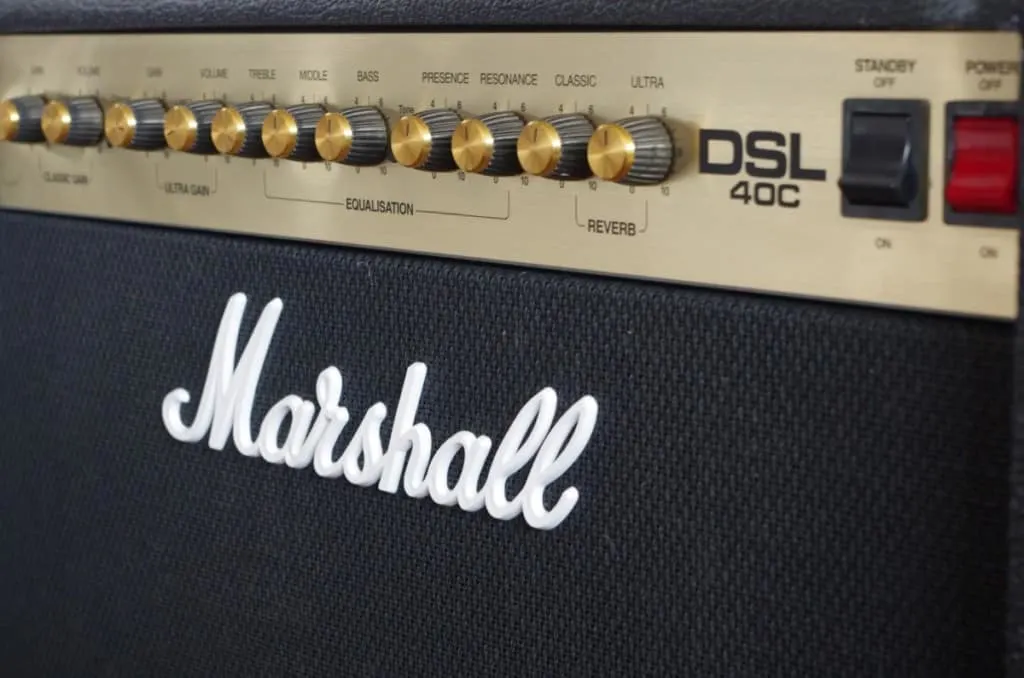The costs of being a guitarist soon start to add up.
There’s the instrument itself, an amplifier, cables, pedals, strings, picks, straps, etc. With all these to purchase, it makes sense that you would want to keep your amp’s electricity usage to a minimum.
Do amplifiers use a lot of electricity?
The average electrical consumption per hour of an amplifier is 100 to 200 watts. To put that into perspective, they use a similar amount of electricity as a refrigerator, slightly more than lights on the ceiling, and ten times less than a standard air conditioner.
Although 100 to 200 watts is the average consumption of a guitar amplifier, the subject is not as straightforward as it may seem.
With so many amplifiers on the market, each boasting different features and inner components, it’s important to consider all of the variables to definitively establish whether amplifiers use a lot of electricity.
Read on to get an in-depth explanation of this topic.

Amplifiers & Electricity Consumption
As we’ve established, the average amount of electricity used by a guitar amplifier falls between 100 and 200 watts per hour.
This number, of course, considers amplifiers of all shapes and sizes, makes, and models. Therefore, it is accurate only as a broad guideline, and in reality, many amplifiers may use significantly more or less electricity than this average amount.
The electricity that an amplifier uses depends on several factors. There’s the power consumption of the amp which varies depending on the size, whether it is of the solid-state or valve variety, the volume that the amplifier is set to, and the amount of time it is used for.
All of these variables contribute to the overall amount of electricity that a particular amplifier will use.
The louder the volume, the more power the amp will require to produce the desired dynamic level. Solid-state and tube amps work in completely different ways, have contrasting inner components, and as a result, use a different amount of electricity.
In the table below, you can see the power consumption of some popular amplifiers, along with the fuse value. Fuse value is indicative of the amount of electricity that the amplifier uses and can be found on the back of the amp, usually on a label.
| Amplifier Make & Model | Electricity Consumption | Value of fuse |
| Marshall Amp | 240 Watts | 2 Amps |
| Fender Reverb | 300 Watts | 2 ½ Amps |
| Line 6 Spider Jam | 600 Watts | 5 Amps |
| Orange Crush 35 | 240 Watts | 2 Amps |
| Roland Cube Street | 2.5 Watts | 0.235 Amps |
| BOSS Katana-50 | 47 Watts | 0.7 Amps |
As you can see from the above table, the fuse value of an amplifier is directly correlated to the amount of electricity it uses. I have presented a mixture of the valve and solid-state amplifiers to show the general difference between the two.
Although observing these numbers is a good way to predict how much electricity an amplifier will use, other factors also must be considered to come up with an accurate number.
Let’s say you have a Line 6 Spider Jam amplifier, which uses a lot of electricity due to its fuse value and solid-state makeup. If you are only using this amp for short periods, at low volumes, then it won’t use much electricity.
Similarly, if you were using the Roland Cube Street, which is an amplifier that uses a very low amount of electricity, but you were using it for hours on end and pushing it to its dynamic limits, then its power consumption would soon start to accumulate.
Check Out The Roland Street Amp here on Amazon.
Output Power & Electricity Consumption
When trying to determine if an amplifier uses a lot of electricity, it may seem logical to link the output power to the power consumption.
Unfortunately, it’s not that simple, and there is often confusion over the amount of power that is drawn by the amplifier, compared to the amount of power it is capable of producing.
If an amplifier is described, for example, as being a “50-watt amp”, this is referring to the amount of power that it is capable of producing. As a result, 50 watts would be sent to the speakers from the amp.
On the other hand, the power consumption of an amplifier refers to the amount of electricity that is drawn from the mains plug. Generally speaking, this number will be significantly higher than the amount of power that the amp is sending to the speaker.
Where things start to get confusing, is when an amplifier is used at a low volume. The labeled wattage of an amp is likely to be much higher than the wattage it uses when it isn’t used to its maximum volume, so it may not use a lot of electricity in this instance.
- One of the main reasons that the power usage of an amplifier is much higher than the power that it is sending to the speakers, is due to the loss of heat. The energy that is lost in the process of powering the amplifier can cause the electricity it uses to drop significantly.

Class A vs. Class AB Amplifiers. Power Consumption Explained
One reliable way to determine whether or not an amplifier uses a lot of electricity is by differentiating between two types of amps.
These are known as Class A and Class AB amplifiers, and although both are very popular, they have contrasting inner components that impact the amount of power they use.
To analyze the technicalities, Class A amplifiers differ from Class AB amplifiers on the point at which the transistors are biased.
Class A amplifiers have transistors that are biased to cater for the full cycle of the RF input, and therefore the transistor operates in the confines of its linear section.
Conversely, the input cycle of a class AB amplifier turns the transistor off.
I know this might sound complex, but don’t worry, all will become clear. The impact that choosing Class A amplifiers or Class AB amplifiers has on the amount of electricity used shouldn’t be underestimated, so it’s important to understand exactly why this is the case.
This video provides an overview of the subject.
Do Class A Or Class AB Amplifiers Use More Electricity?
Class AB amplifiers use much less electricity than their counterparts. They are more efficient in terms of power consumption and cost. To put this into “guitarist terms”, the majority of Fender and Marshall amplifiers fall into the Class AB category, while the legendary British Invasion manufacturers, Vox, fall into the Class A category.
So, Vox amplifiers use a lot of electricity compared to Fender and Marshall options.
This is because, in a Class A amplifier circuit, a certain process occurs. There is a positive voltage applied to the circuit grid, which overlooks the flow of electrons. A class A circuit design requires the current to be flowing continuously through the amplifier’s tube, therefore, a lot of electricity is being used.
Alternatively, in a Class AB amplifier’s circuit, there is a negative bias voltage to which the grid is subjected to. This causes the tube to turn off when the audio waveform drops below a particular point. Much like a compressor, this device reads the dynamics of the audio wave and responds accordingly.
Simultaneously, a separate tube and circuit become active just before the prior mentioned one switches off.
This circuit produces the remainder of the waveform, sharing the burden between itself and the other tube and circuit that started the process.
Below is a brief overview of the pros and cons of Class A and Class AB amplifiers.
| Class A | Class AB |
| Uses more electricity | Tubes last for longer |
| The signal is amplified instantly | More clarity in the low-end |
| Produces louder volumes than AB amps | Uses less electricity |
| Tubes are constantly strained | Less demand on the transformer |
| Tube life is shorter | Less responsive than Class A amps |
Related Questions On Amps And Electricity Consumption
Do tube amps have built-in effects?
Traditionally, there are two main effects included on tube amplifiers. Since the 1960s, Fender has installed tremolo and reverb units in their amps.
These effects can be added to the output of the amplifier using dedicated rotary knobs. In the modern era, the sound of authentic tremolo and reverb effects from vintage amps have been replicated in many effects pedals.
Can you send vocals into a guitar amp?
Some guitar amps do offer inputs for vocals mics. However, because the speakers are specifically suited to the timbre and frequency range of an electric guitar, vocals are not guaranteed to sound good when sent into a guitar amp.
It depends on the sound you intend to create, and the quality of the speaker cones within the amplifier.
I have written an article on the differences between amplifiers, you can read it here.
Do you need an amplifier to record the electric guitar?
Indeed, recording electric guitar in years gone by would certainly require an amplifier.
As music technology has progressed, devices called audio interfaces have become more popular. These devices allow you to plug an electric guitar straight into their input, and record into a DAW of your choice. It is therefore not necessary to use an amplifier to record electric guitar.
I hope this helps clear up some of the questions you have on electricity consumption of the modern-day guitar amp. Thanks for stopping by!
